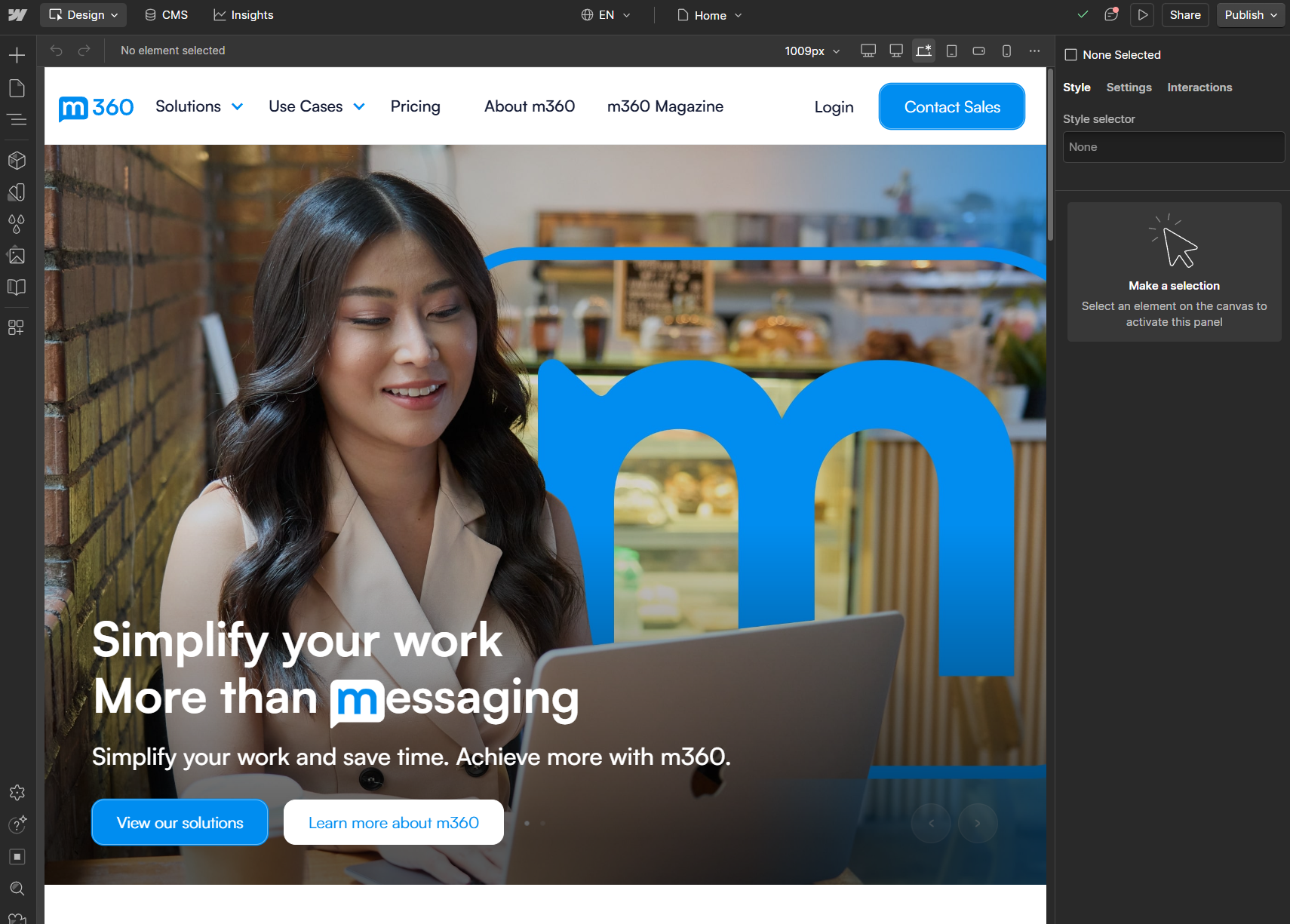Website Revamp & Launch: Strategic Platform Migration and UX Ownership Drives 200% Visitor Growth
-
The company approved a critical website redesign to secure a key business touchpoint, but significant organizational roadblocks exposed a deeper strategic problem:
Ownership Bottleneck: The critical website touchpoint was officially owned and maintained by the Development Team. The Development Team confirmed zero resource availability for the required roles for the remainder of the fiscal year, as the project was not prioritized in their pipeline. This structure meant UX had no direct path to deployment.
Technology Limitation: The current technology stack—under Development Team ownership—could not support integrations for future critical enhancements, such as a necessary Lead Management System (LMS), hindering long-term digital growth plans.
Strategic Goal: As the UX Lead in the Innovation Group, I pursued this as a direct initiative to take ownership of the touchpoint from the bottlenecked Development Team, circumvent the resource crisis, and ensure and oversee the touchpoint experience for the customer.
-
UX Team (Innovation Group) (Initiative & Development Lead: Me):
Responsibility: Strategy Vetting, Budget Pitch, Full execution of the build, delegation, project control, and management of internal QA execution and upskilling. Crucially, secured and now manages the long-term Website Governance.
Marketing (Asset Owner & Final Decision Maker):
Responsibility: Budget approval, requirements definition, final go/no-go decision on deployment, content migration, and UAT sign-off.
QA Team (Final Quality Assurance Sign-off):
Responsibility: Final QA certification of the live-ready product, ensuring compliance with organizational standards.
External Agency (Design Provider):
Responsibility: Provided initial visual design concepts (pre-build phase).
-
By championing a strategic platform shift and successfully pursuing an independent budget, I led the team to launch the site weeks ahead of internal estimates.
Growth: Monthly visitors increased by 200% (from 5k to 20k).
Ownership: I established strategic UX ownership of a core business touchpoint for the Innovation Group.
Agility: I demonstrated the ability to circumvent critical development resource bottlenecks and technology limitations using a design-led development model.
Phase 1: Planning & Strategy
The existing technology stack required unavailable development resources. I developed a pitch for Webflow based on a strategic, consolidated value proposition:
Comprehensive Stack: Webflow offered an all-in-one solution, including CMS, low-code development, integration capabilities, multiple access management, and hosting.
Agility & Cost Efficiency: This stack ensured lower long-term maintenance costs and enabled the UX team to manage development without full coding knowledge, providing a solution outside of the resource bottleneck.
Stakeholder Management and Executive Pitch:
To eliminate risk and secure buy-in from the asset owner, I first spearheaded a 1-week Proof-of-Concept (POC), building a fully functional homepage prototype. By physically demonstrating the ease and speed of development to Marketing leadership, I was able to convince them of the feasibility and viability of the platform change.
With Marketing's commitment secured, I then presented the approach to executives to obtain high-level approval for the strategic shift. This success allowed I to successfully secure the Marketing team's budget to invest in our solution and obtain the strategic mandate for the UX Team to take ownership of the asset, controlling the execution path.
Phase 2: Developing
My focus was on rapid execution and resource replacement.
Eliminating Developer Dependency: I took the initiative to study and understand Webflow development. To replace the unavailable Front-End resource, I then shared and delegated tasks by upskilling the UX team to become full-stack contributors.
CMS Design and Development: I designed the CMS structure, and collaborated with the UX team to build and finalize the CMS architecture within Webflow, ensuring it met long-term content requirements.
Process Control & Risk Mitigation: To ensure process control, I personally secured and designed the strategy for all necessary redirections from the old platform. In collaboration with Marketing and the UX team, I delegated the validation and implementation of these crucial redirections. Furthermore, I created internal QA test cases and directed quality assurance tasks within our UX team, guaranteeing quality control ahead of final organizational sign-offs.
Phase 3: Launch
The strategic pivot delivered measurable results:
Time-to-Market: The website was launched on time/early, weeks faster than the estimated timeline, demonstrating strategic agility.
Growth Impact: Monthly website visitors increased by 200% (from 5k to 20k), validating the UX-driven migration and strategic focus on the digital funnel.
Future Readiness: Technology debt was resolved, and the new platform supports full API integration for critical systems like the LMS.
Phase 4: Govern
I secured long-term Website Governance for the UX Team, ensuring control over the touchpoint experience.
My Governance Framework established a condensed internal process for all changes: Low-Risk Changes are handled by Marketing with an immediate push to live. Medium-Risk Changes require a Staging Check and final sign-off from Me before deploying during standard hours. High-Risk Changes (e.g., code, API, and vital integrations) require a Staging Check, final sign-off from the QA Team, and are deployed only during off-hours.
Operational Oversight: Ongoing governance includes continuous monitoring of website analytics, active management of security and technical risks associated with the platform, and daily tracking of lead queries to ensure the digital funnel remains effective.
I became the long-term owner and main contact for the website, successfully solidifying the UX function's role as the authority on customer journey and digital execution.


